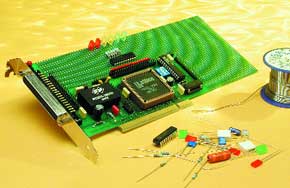PCI Bus Prototyping Card (1)
Explore the PCI-Bus

This is a MEMBER ONLY article. You need a subscription to read this article.
- Access to Elektor archive and 5,000+ Gerber files
- Receive up to 8 magazines per year (digital and/or paper)
- 10% discount in the Elektor store
Available from €4.95 per month.
What is Members Only
Elektor is committed to providing high-quality content on electronics, catering to tens of thousands of paying members. As part of this commitment, Elektor has launched Premium, an initiative that offers exclusive online articles to members sometimes even before they appear in the magazine.
Every day, members can access in-depth articles that showcase the best of Elektor's premium content.
This initiative aims to reward members with early access. Once logged in, members can easily enjoy this exclusive content and engage in discussions about featured projects. While Premium adds to the existing resources available, Elektor will continue to provide a wealth of free information.
Join the Elektor community today to take advantage of Premium and other benefits!
Materials
Gerber file
CAM/CAD data for the PCB referred to in this article is available as a Gerber file. Elektor GREEN and GOLD members can exclusively download these files for free as part of their membership. Gerber files allow a PCB to be produced on an appropriate device available locally, or through an online PCB manufacturing service.
Elektor recommends the Elektor PCB Service service from its business partner Eurocircuits or AISLER as the best services for its own prototypes and volume production.
The use of our Gerber files is provided under a modified Creative Commons license. Creative Commons offers authors, scientists, educators and other creatives the freedom to handle their copyright in a more free way without losing their ownership.
Component list
R1,R4 = 1k
R2 = 22k
R3 = 3k 9
R5,R6 = array 8 x 10k
Capacitors:
C1-C5,C10,C11,C13,C14 = 100nF
C6,C7 = 100µ F 16V
C8,C9 = 10nF
C12 = 220µ F 16V
Inductors:
L1,L2,L3 = 2µ H7 (see text)
Semiconductors:
D1 = LED
IC1 = ispLSI1032 (available from Kolter Elektronik)
IC2 = GAL22V10 (order code 010009-31)
IC3 = oscillator module in 8-pin DIL case (see text)
IC4 = NMH0515S (see text)
Miscellaneous:
K1 = PCB edge connector for PCI bus
K2,K3 = 16-pin SIL pinheader
K4 = 37-pin sub-D socket
K5 = 34-pin boxheader or pinheader
K6 = not fitted**
K7 = not fitted **
K8,K9,K10= 6-pin pinheader
S1 = 4-way DIP switch
PCB, order code 010009-1*** See text



Discussion (0 comments)